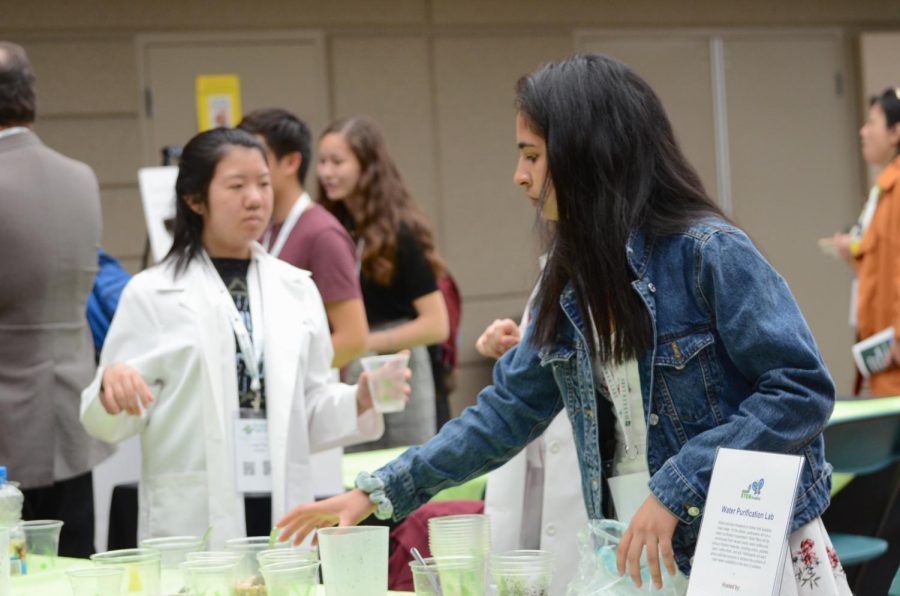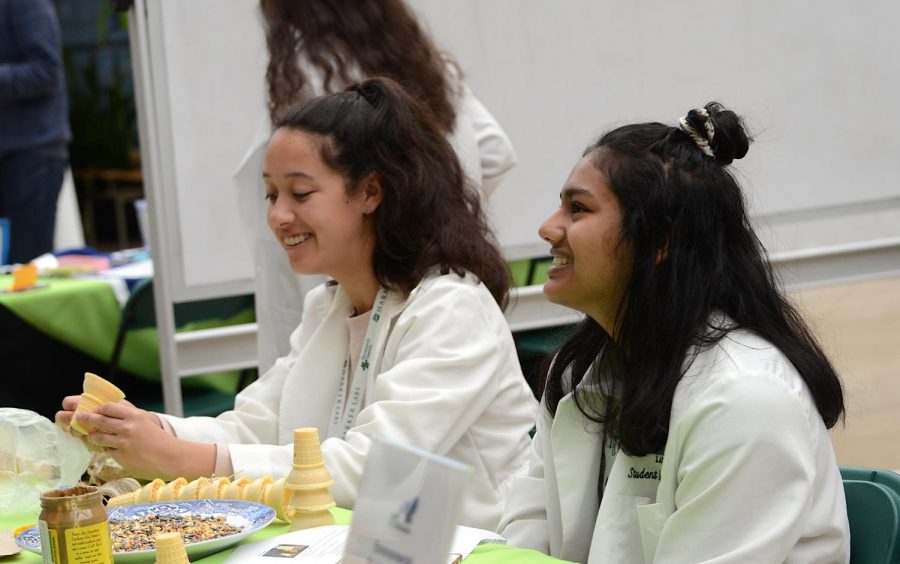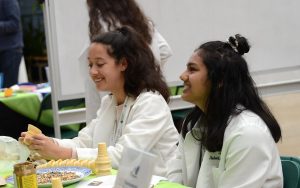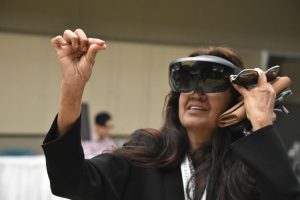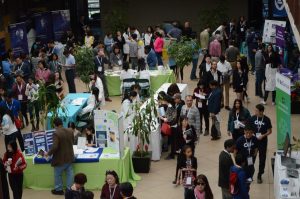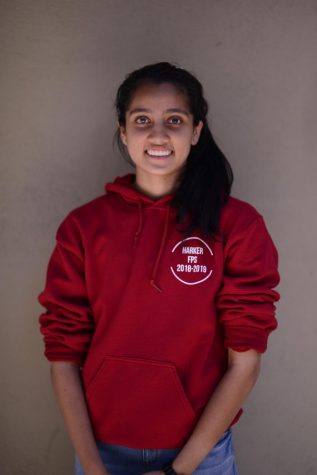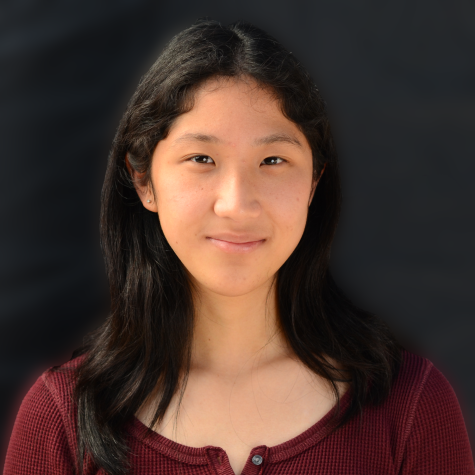14 years of celebrating innovation and inquiry: diving into a Harker research tradition
Advika Phadnis (10) and Luisa Pan (10) organize cups around the Water Purification station. The theme for this year’s research symposium was ““Our Survival: Saving the Planet and Healing Ourselves.”
April 27, 2019
The upper school was buzzing with action from 8 a.m. to 5 p.m. on Saturday, April 13, as the Women in STEM club (WiSTEM) hosted the 14th annual Harker Research Symposium with the theme “Our Survival: Saving the Planet and Healing Ourselves.” This popular community-wide event has grown exponentially from the first research symposium in 2006 with 35 attendees to 900 attendees from all four campuses this year.
This year, WiSTEM advisor and science department chair Anita Chetty wanted to have a more global and more impactful symposium.
“I felt it was not only timely, but necessary, for us to spend a day thinking about the planet and the changes that it’s undergoing,” Chetty said. “It’s important to think about what you can change to lessen the blow. It’s about us, so to go beyond just pure research to now saying, how can I use what I just learned to make a change?”
At the opening ceremony in the Athletic Center, there were two vocal performances by the Cantilena and Camarata groups: “We Belong to Earth” by Ted Perry and “Earth Blessing” by Dr. Jack Manno.
This year’s morning keynote speaker, Max Holmes, a senior climate scientist at Woods Hole Research Center, discussed his research on rivers and their watersheds and how they are being impacted by climate change.
His talk was followed by the introductory STEMnovation Challenge 2019 in which the finalists pitched their ideas to solve a green problem currently affecting the local community and/or larger Earth. The winning team of freshmen Simren Kochhar, Camilla Lindh and Ishaan Parate was awarded$5,000 for their innovative product idea H2OOT, which will provide real-time individual water usage data and help in saving water.
Another highlight from the morning session was the alumni panel discussion Eagles Fly Back Home, which was moderated by upper school division head Butch Keller. Charitha Reddy ‘03, Chadwick Manning ‘04, Shephalie Lahri ‘05 and Jigish Patel ‘03 shared their experiences in their high school journey and gave advice to the students to be resilient, passionate and consistent and discussed what it means to be successful.
Upper school students presented formal talks in breakout sessions throughout the morning. Middle school and high school students also enthusiastically explained their research in detail to audience members at the poster sessions. The research varied amongst different fields, including projects in software engineering, chemistry, behavioral science, earth and environmental science, plant science, physics and astronomy, biochemistry and microbiology, electrical engineering, biomedical and health, and animal science.
William Rainow (11) presented his project about water fluoridation in Silicon Valley for the first time at the symposium.
“It’s been a lot of fun; I really like the process,” William said. “There [had] been a lot of setbacks, but in the end, because I had so much practice, it’s gone a lot smoother now that I actually know how to perform the tests and experiments.”
Although the main objective of the research symposium is an opportunity for Harker students to share and communicate their research in a non-competitive setting, the symposium also hosts corporate exhibits and workshops that provide mentoring opportunities.
“The exhibitors connect research and development with the economy and show students how what they are currently learning to do impacts careers, future studies, etc.,” Chetty said. “I also wanted this to be a chance for students to mentor younger students, so a big part of the research symposium is to inspire curiosity and scientific research and scientific thinking amongst younger students.”
During the lunch break there were interactive booths sponsored by upper school clubs like Research Club, Green Team and Robotics Club. Various companies like NVidia, Eureka Therapeutics, Fountain Medical Development, Electriq Power, Lyratone Acoustics and 3E Bioventures Capital also had exhibits. Stanford Solar Car Project raised community awareness of clean energy vehicles with its exhibit.
David Melisso (12) was at the robotics booth demonstrating the team’s 2018 robot. The team let different people use the robot with the controllers and also gave a tour of the robotics lab, the different tools and how they build a robot.
“I really like it; there’s so many interesting things here,” David said. “There’s a lot of demos around, all the different people are doing talks, and I liked the thing at lunch where teachers were showing demos: I think it’s all pretty cool.”
As the budding scientists filled their appetite with a boxed lunch of wraps, chips, fruit and yogurt, the quad was packed with an audience for the popular annual chemistry magic show conducted by upper school chemistry teachers Andrew Irvine and Dr. Smriti Koodanjeri.
After magical chemistry, the attendees returned to the athletic center for a special alumni keynote address by Surbhi Sarna ‘03 on the challenges, heartaches, and successes of her entrepreneurial journey as a CEO and President of nVision Medical to create an early detection mechanism for ovarian cancer.
Sarna’s talk was followed by the afternoon keynote address given by Dr. David Haussler, scientific director of UCSC Genomics Institute. Haussler took the audience on a journey into the history of the human genome, discussing its evolution, significance and revolutionary potential in aiding the advancement of science and medicine
Throughout the day, the symposium included student talks by Regeneron finalists Ruhi Sayana, Natasha Maniar and Ayush Alag along with Kat Zhang and Regeneron semifinalist Kat Tian about their research, all seniors.
The day ended with a panel discussion kicked off by Chetty and upper school science teacher Chris Spenner and led by Harker students and a Harker parent discussing various research opportunities, their own individual journeys and the real prize in conducting research.
WiSTEM project coordinator Rashmi Iyer (11) noted that team effort that went into setting for the symposium was one of the most enjoyable parts of the process.
“The best part of [the] symposium was seeing all the WiSTEM members come together and do such a great job in making a great symposium,” Rashmi said.
WiSTEM celebrated the completion of a successful research symposium with an ice cream party for its volunteers. Chetty enjoys reflecting on the things that did go as planned.
“I try very hard not to think about the things that didn’t work, and just kind of savor the hours of work, and say that it went off the way that I had planned,” Chetty said.
The research symposium for 2020 has been set for April 11, 2020, and the theme for next year is “Robotics and Automation.”
Additional reporting by Nicole Tian.


















![“[Building nerf blasters] became this outlet of creativity for me that hasn't been matched by anything else. The process [of] making a build complete to your desire is such a painstakingly difficult process, but I've had to learn from [the skills needed from] soldering to proper painting. There's so many different options for everything, if you think about it, it exists. The best part is [that] if it doesn't exist, you can build it yourself," Ishaan Parate said.](https://harkeraquila.com/wp-content/uploads/2022/08/DSC_8149-900x604.jpg)




![“When I came into high school, I was ready to be a follower. But DECA was a game changer for me. It helped me overcome my fear of public speaking, and it's played such a major role in who I've become today. To be able to successfully lead a chapter of 150 students, an officer team and be one of the upperclassmen I once really admired is something I'm [really] proud of,” Anvitha Tummala ('21) said.](https://harkeraquila.com/wp-content/uploads/2021/07/Screen-Shot-2021-07-25-at-9.50.05-AM-900x594.png)







![“I think getting up in the morning and having a sense of purpose [is exciting]. I think without a certain amount of drive, life is kind of obsolete and mundane, and I think having that every single day is what makes each day unique and kind of makes life exciting,” Neymika Jain (12) said.](https://harkeraquila.com/wp-content/uploads/2017/06/Screen-Shot-2017-06-03-at-4.54.16-PM.png)








![“My slogan is ‘slow feet, don’t eat, and I’m hungry.’ You need to run fast to get where you are–you aren't going to get those championships if you aren't fast,” Angel Cervantes (12) said. “I want to do well in school on my tests and in track and win championships for my team. I live by that, [and] I can do that anywhere: in the classroom or on the field.”](https://harkeraquila.com/wp-content/uploads/2018/06/DSC5146-900x601.jpg)
![“[Volleyball has] taught me how to fall correctly, and another thing it taught is that you don’t have to be the best at something to be good at it. If you just hit the ball in a smart way, then it still scores points and you’re good at it. You could be a background player and still make a much bigger impact on the team than you would think,” Anya Gert (’20) said.](https://harkeraquila.com/wp-content/uploads/2020/06/AnnaGert_JinTuan_HoHPhotoEdited-600x900.jpeg)

![“I'm not nearly there yet, but [my confidence has] definitely been getting better since I was pretty shy and timid coming into Harker my freshman year. I know that there's a lot of people that are really confident in what they do, and I really admire them. Everyone's so driven and that has really pushed me to kind of try to find my own place in high school and be more confident,” Alyssa Huang (’20) said.](https://harkeraquila.com/wp-content/uploads/2020/06/AlyssaHuang_EmilyChen_HoHPhoto-900x749.jpeg)



